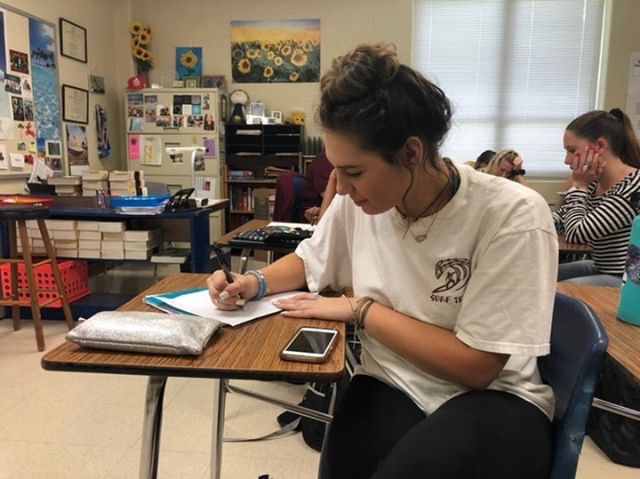The write way
District brings back cursive
Senior Kayleigh Petray in her fifth period English class, writing in her preferred handwriting style.
May 23, 2019
We all hold the common idea that as society grows and technology evolves, we should grow with it. This concept can leak into important aspects of education. The one most heavily in question being cursive writing. Cursive being implemented in curriculum has been a debate for years, but the elementary schools in Comal ISD will see a new wave of the looped letters.
Many believe cursive is an important skill and shows productive results as opposed to print. Cursive is beneficial to students learning to write due to its structure.
“There is a large body of research that shows that teaching cursive to a student yields positive benefits,” Curriculum specialist Helen Hedemann said. “To begin with, because cursive is written in a natural flow, it is more relaxing to the hand. Interestingly, all lowercase cursive letters begin in the same spot on the baseline, moving left to right and flow directly into the next letter, so this helps to limit the likelihood of letter reversals.”
Cursive writing will be introduced in second, instead of third grade, and taught and practiced between the second through fifth grade levels.
“Our district provides with resources to both guide teachers in teaching cursive and provide rehearsal practice for students,” Hedemann said. “The new instructional materials we have adopted address the changes made to the standards. In Comal ISD, teaching handwriting is an integral part of reading and writing.”
Cursive writing is a skill many kids continue to use even after elementary school. Senior Kaleigh Petray learned in the first grade, and it is now her primary handwriting of choice. Petray sees cursive as a valuable and important skill to learn.
“I think it is a lost art and should be brought back,” Petray said. “It is what our Constitution and Declaration of Independence is written in and I would like future generations to be able to read it.”
As well as forming a solid foundation for young students to learn to write and spell, cursive writing is also beneficial to people with dyslexia and dysgraphia. Children with dyslexia or dysgraphia who are taught to write in cursive tend to experience significant improvement in reading and writing.
Cursive writing also combines brain and memory functions with fine motor skills and hand eye coordination, helping the brain make connections between letter shapes and sounds.
Reinstating cursive into the curriculum in Texas is a big step. Soon enough, the handwriting will be reintroduced as a whole in America’s public schools.


